Spatiotemporal Analysis of Photovoltaic Potential in Ordos City Based on an Improved CRITIC Method
Abstract
1. Introduction
2. Materials and Methods
2.1. Study Region
2.2. Data Sources
2.3. Research Methods
2.3.1. Construction of PV Development Potential Evaluation System
2.3.2. Improved CRITIC Method
2.4. Validation
2.5. Analysis of Method Optimization Effects
3. Results
3.1. Temporal Change Characteristics of PV Development Suitability
3.2. Spatial Distribution Characteristics of PV Development Suitability
4. Discussion and Conclusions
- (1)
- Methodological Advancement: The improved CRITIC method effectively mitigated weight bias from extreme values (e.g., reducing nighttime light weight from 0.24 to 0.14) by incorporating coefficient of variation and absolute correlation, demonstrating higher robustness in sparse-population regions.
- (2)
- Spatiotemporal Patterns: The proportion of suitable areas (Level III+) increased from 23.96% (2010) to 48.24% (2022), with center of spatial shifting southwestward, aligned with infrastructure upgrades and urbanization-driven energy demand.
- (3)
- Spatial Optimization: Level I areas clustered in eastern Ordos, benefiting from flat terrain and proximity to high-consumption zones, while western deserts exhibited potential for PV-desertification control synergy.
- (1)
- This study improves the CRITIC weighting method and uses it to optimize parameter weights. Based on the characteristics of the CRITIC weighting method, under the premise of a limited study area and small changes in natural conditions, it emphasizes the impact of the correlation and conflict between parameters on PV construction suitability from the perspectives of construction costs and consumption capacity.
- (2)
- This study only considers the impact of local consumption capacity on PV development suitability and discusses the contribution of PV power generation to power peak shaving. Given that PV power is currently mainly consumed locally and the impact of power transmission on this study is small, with high power storage costs, this study does not include the impact of power transmission and storage on PV suitability. With the restrictions on surplus power grid connection policies and the continuous improvement of power transmission lines, future research should consider the impact of such parameters on PV suitability.
Author Contributions
Funding
Data Availability Statement
Conflicts of Interest
References
- Qiang, H.; Yi, G.; Jianhua, J.; Bo, M. “Dual Carbon” Goals and China’s Clean Electricity Development Path. J. Shanghai Jiao Tong Univ. 2021, 55, 1499–1509. [Google Scholar]
- Sun, Y.; Gao, W.; Lu, J. New Opportunities for Photovoltaic Development under the “Dual Carbon” Goals and Its Application in Energy Networks. Digit. Commun. World 2023, 70, 124–126. [Google Scholar]
- Bai, R. Research and Application of “PV + Land Comprehensive Management” Model. Sol. Energy 2022, 7, 10–13. [Google Scholar]
- Bao, Z.; Shi, R.; Huang, Y.; Song, X. Photovoltaic Generation Potential and Developmental Suitability in Southern Hebei. Energy Rep. 2023, 9 (Suppl. S7), 795–805. [Google Scholar] [CrossRef]
- Miharu, N.; Takeshi, O. Assessment of Suitability for Photovoltaic Power Generation in Periurban Seminatural Grasslands: Toward the Coexistence of Seminatural Grasslands and Photovoltaic Power Generation. Discov. Sustain. 2024, 5, 141. [Google Scholar]
- Alexandra, V.; Monica, D.; Gheorghe, K. Site Suitability for Photovoltaic Farms and Current Investment in Romania. Renew. Energy 2022, 187, 320–330. [Google Scholar]
- Liu, L.; Sun, Z.; Wu, F.; Zhang, X.; Zhang, Q. Spatial Suitability and Emission Reduction Benefits of Photovoltaic Development in the Beijing-Tianjin-Hebei Region. Acta Geogr. Sin. 2022, 77, 665–678. [Google Scholar]
- Xu, W.; Liu, Z.; Liu, S. Suitability of Photovoltaic Development and Emission Reduction Benefits Based on Geographic In-formation Sensing and Multi-Criteria Decision Making Method—An Example from Inner Mongolia Autonomous Region. Front. Energy Res. 2023, 11, 1222306. [Google Scholar] [CrossRef]
- Zhang, Q.; Xin, X.; Zhang, H.; Li, Y.; Li, X.; Yi, C. Suitability Analysis of Photovoltaic Power Plants in China Using Remote Sensing Data and Multi-criteria Evaluation. J. Geo-Inf. Sci. 2018, 20, 119–127. [Google Scholar] [CrossRef]
- Liu, W.; Guo, D.; Xu, Y.; Cheng, R.; Wang, Z.; Li, Y. Reliability Assessment of Power Systems with Photovoltaic Power Stations Based on Intelligent State Space Reduction and Pseudo-Sequential Monte Carlo Simulation. Energies 2018, 11, 1431. [Google Scholar] [CrossRef]
- Miao, X.; Li, J.Y.; Liu, Y.M.; Song, X.Y. Evaluation and attribution analysis of ecological vulnerability in Ordos City. J. Northwest Coll. For. 2023, 38, 168–173. [Google Scholar]
- Liu, L. GLC_FCS30D: 1985-2022 Global 30 m Fine Land Cover Dynamic Monitoring Dataset; International Research Center of Big Data for Sustainable Development Goals: Beijing, China, 2023. [Google Scholar]
- Louwen, A.; van Sark, W.G.J.H.M.; Faaij, A.P.C.; Schropp, R.E.I. Re-assessment of net energy production and greenhouse gas emissions avoidance after 40 years of photovoltaics development. Nat. Commun. 2016, 7, 13728. [Google Scholar] [CrossRef] [PubMed]
- Modi, V.V.; Patel, K.S. Performance evaluation of agrivoltaic system for the synergy among greengram (Vigna radiata L. Wilczek) production and solar electric power generation. Energy Sci. Eng. 2024, 12, 5385–5397. [Google Scholar] [CrossRef]
- Marrou, H.; Wery, J.; Dufour, L.; Dupraz, C. Productivity and Radiation Use Efficiency of Lettuces Grown in the Partial Shade of Photovoltaic Panels. Eur. J. Agron. 2013, 44, 54–66. [Google Scholar] [CrossRef]
- Aydi, A. Evaluation of groundwater vulnerability to pollution using a GIS-based multi-criteria decision analysis. Groundw. Sustain. Dev. 2018, 7, 204–211. [Google Scholar] [CrossRef]
- Peng, S.; He, J.; Liu, T.; Li, B.; Su, S.; Zhuang, J. Evaluation of Distributed Photovoltaic Potential on Urban Roofs Based on Satellite Images. Acta Energiae Sol. Sin. 2024, 45, 517–526. [Google Scholar] [CrossRef]
- Li, Y.; Zhou, J.; Feng, Z. Location of Mountain Photovoltaic Power Station Based on Fuzzy Analytic Hierarchy Process—Taking Longyang District, Baoshan City, Yunnan Province as an Example. Sustainability 2023, 15, 16955. [Google Scholar] [CrossRef]
- Bahaa, E.; Mamdooh, A.; Reda, A.H.M.; Zalhaf, A.S. A Suitability Mapping for the PV Solar Farms in Egypt Based on GIS-AHP to Optimize Multi-Criteria Feasibility. Ain Shams Eng. J. 2022, 13, 101618. [Google Scholar]
- Foad, M.; Masoud, M.; Ioannis, K.; Shafizadeh-Moghadam, H.; Hosseini, S.A. Rural Electrification in Protected Areas: A Spatial Assessment of Solar Photovoltaic Suitability Using the Fuzzy Best Worst Method. Renew. Energy 2021, 176, 334–345. [Google Scholar]
- Magalhães, I.B.; de Barros Nogueira, G.C.C.; Alves, I.S.L.; Calijuri, M.L.; Lorentz, J.F.; Alves, S.D.C. Site Suitability for Photovoltaic Energy Expansion: A Brazilian’s High Demand States Study Case. Remote Sens. Appl. Soc. Environ. 2020, 19, 100341. [Google Scholar] [CrossRef]
- Liang, L.; Chen, Z.; Chen, S.; Zheng, X. Evaluation of Site Suitability for Photovoltaic Power Plants in the Beijing-Tianjin-Hebei Region of China Using a Combined Weighting Method. Land 2023, 13, 40. [Google Scholar] [CrossRef]
- Hassim, L.; Coetzee, S.; Rautenbach, V. Electricity Infrastructure Planning: Evaluating Solar Potential Assessments for Informal Settlements Using GRASS and Freely Available Data. Int. Arch. Photogramm. Remote Sens. Spatial Inf. Sci. 2018, XLII-4/W8, 69–76. [Google Scholar] [CrossRef]
- Salah-Eddine, A.; Ahmed, M.A.; Samir, T.; Dekhissi, H. A Multi-Scenario Site Suitability Analysis to Assess the Installation of Large Scale Photovoltaic-Hydrogen Production Units. Case Study: Eastern Morocco. Energy Convers. Manag. 2023, 295, 117615. [Google Scholar]
- Hübl, F.; Welscher, F.; Scholz, J. Multi-Criteria Decision Analysis to Evaluate the Geographic Potential of Alternative Photovoltaic Types. ISPRS Int. J. Geo-Inf. 2024, 13, 269. [Google Scholar] [CrossRef]
- Xu, W.; Liu, Z. Research on Spatial Suitability and Emission Reduction Benefits of Photovoltaic Development in Inner Mongolia. Arid Land Geogr. 2024, 47, 684–694. [Google Scholar]
- Hinestroza-Olascuaga, L.M.; Carvalho, P.M.S.; Jesus, C.M. Using a Multi-Criteria Model to Assess the Suitability of Potential Sites to Implement Off-Grid Solar PV Projects in South America. Sustainability 2021, 13, 7546. [Google Scholar] [CrossRef]
- Yi, S. Spatial Distribution of Solar Energy in China and Comprehensive Potential Evaluation of Regional Development and Utilization. Master’s Thesis, Lanzhou University, Lanzhou, China, 2014. [Google Scholar]
- Wu, W.; Chen, H.; Li, C.; Lu, G.; Ye, D.; Ma, C.; Ren, L.; Li, G. Assessment of the ecological and environmental effects of large-scale photovoltaic development in desert areas. Sci. Rep. 2024, 14, 22456. [Google Scholar] [CrossRef] [PubMed]
- Gel, M. Research on Low-Carbon Development Potential in Western Mongolia Based on the Suitability of Photovoltaic Land Development. Master’s Thesis, Inner Mongolia Normal University, Hohhot, China, 2023. [Google Scholar] [CrossRef]
- Kawase, M.; Okajima, K.; Uchiyama, Y. Evaluation of Potential Geographic Distribution for Large-Scale Photovoltaic System in Suburbs of China. J. Renew. Energy 2013. [Google Scholar] [CrossRef][Green Version]
- Zhou, Q.; Zhou, T. Comprehensive Evaluation Model and Application of Provincial Ground Photovoltaic Development Potential. Electr. Power Sci. Eng. 2024, 40, 28–38. [Google Scholar]
- Qu, Z.; Yang, S.; Xiao, J. Current Status and Potential Analysis of Photovoltaic Power Station Construction in Northwest China under the Dual Carbon Background. Arid Zone Resour. Environ. 2024, 38, 20–26. [Google Scholar] [CrossRef]
- Zhang, H.; Tian, P.; Zhong, J.; Liu, Y.; Li, J. Mapping Photovoltaic Panels in Coastal China Using Sentinel-1 and Sentinel-2 Images and Google Earth Engine. Remote Sens. 2023, 15, 3712. [Google Scholar] [CrossRef]
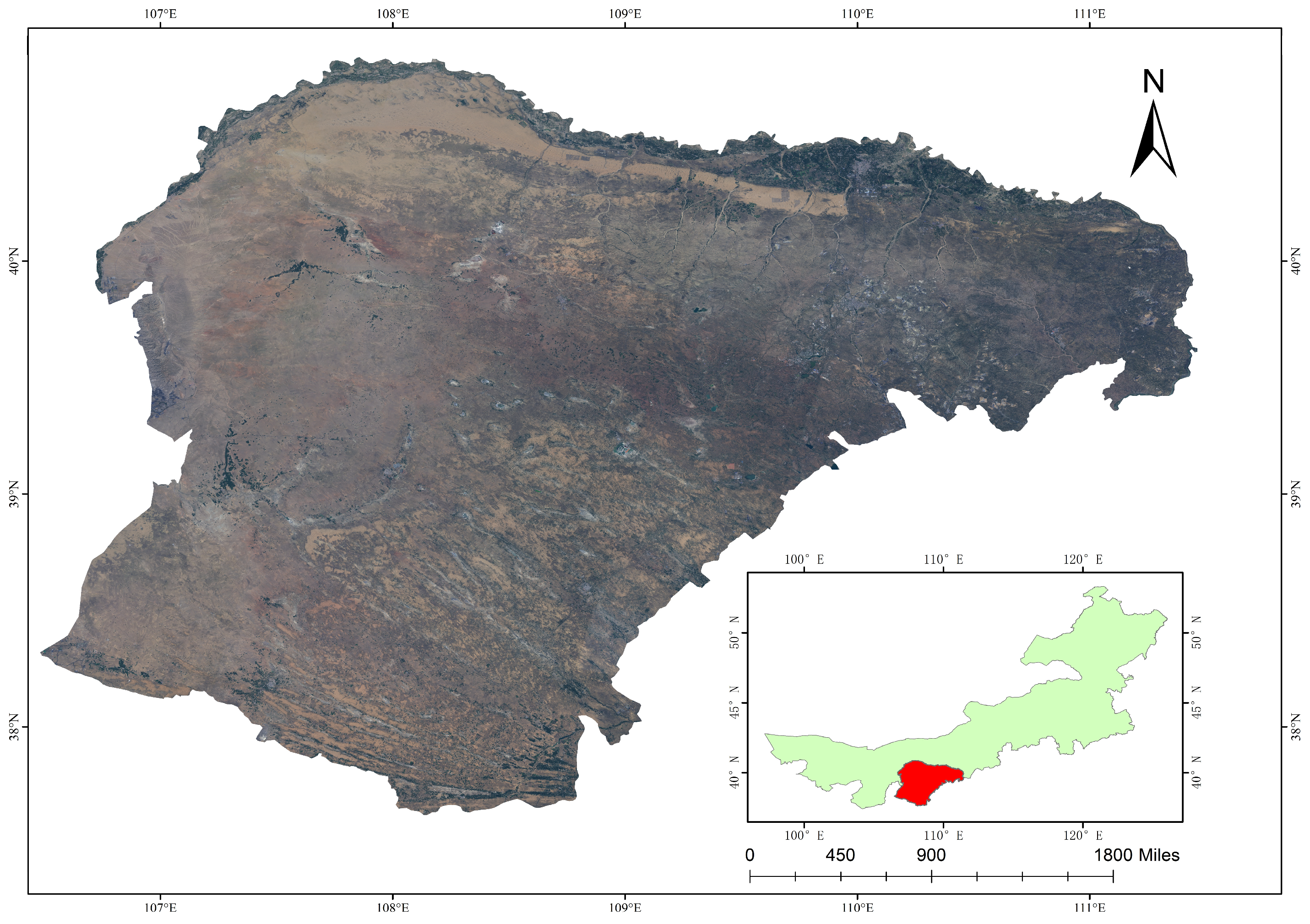
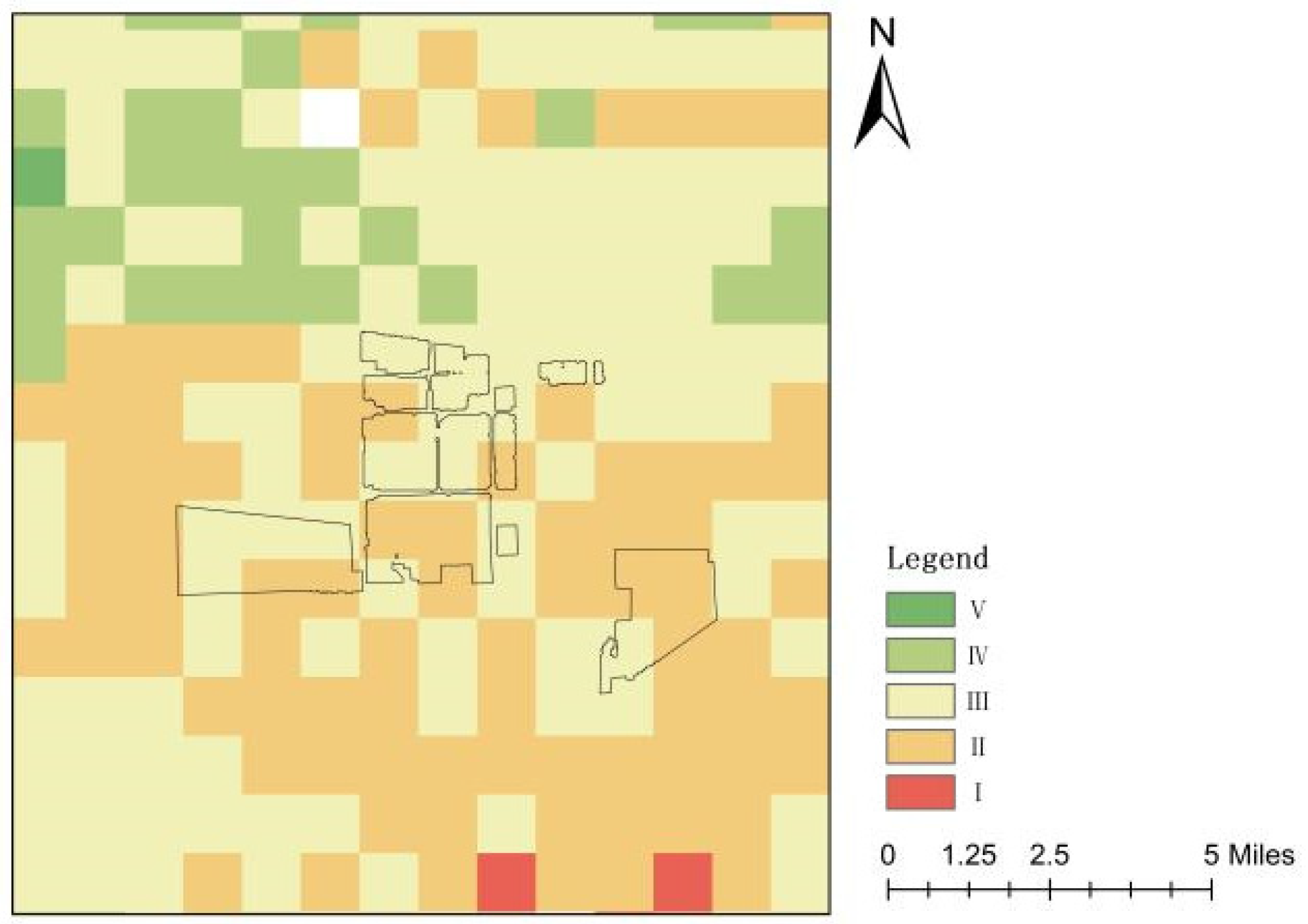
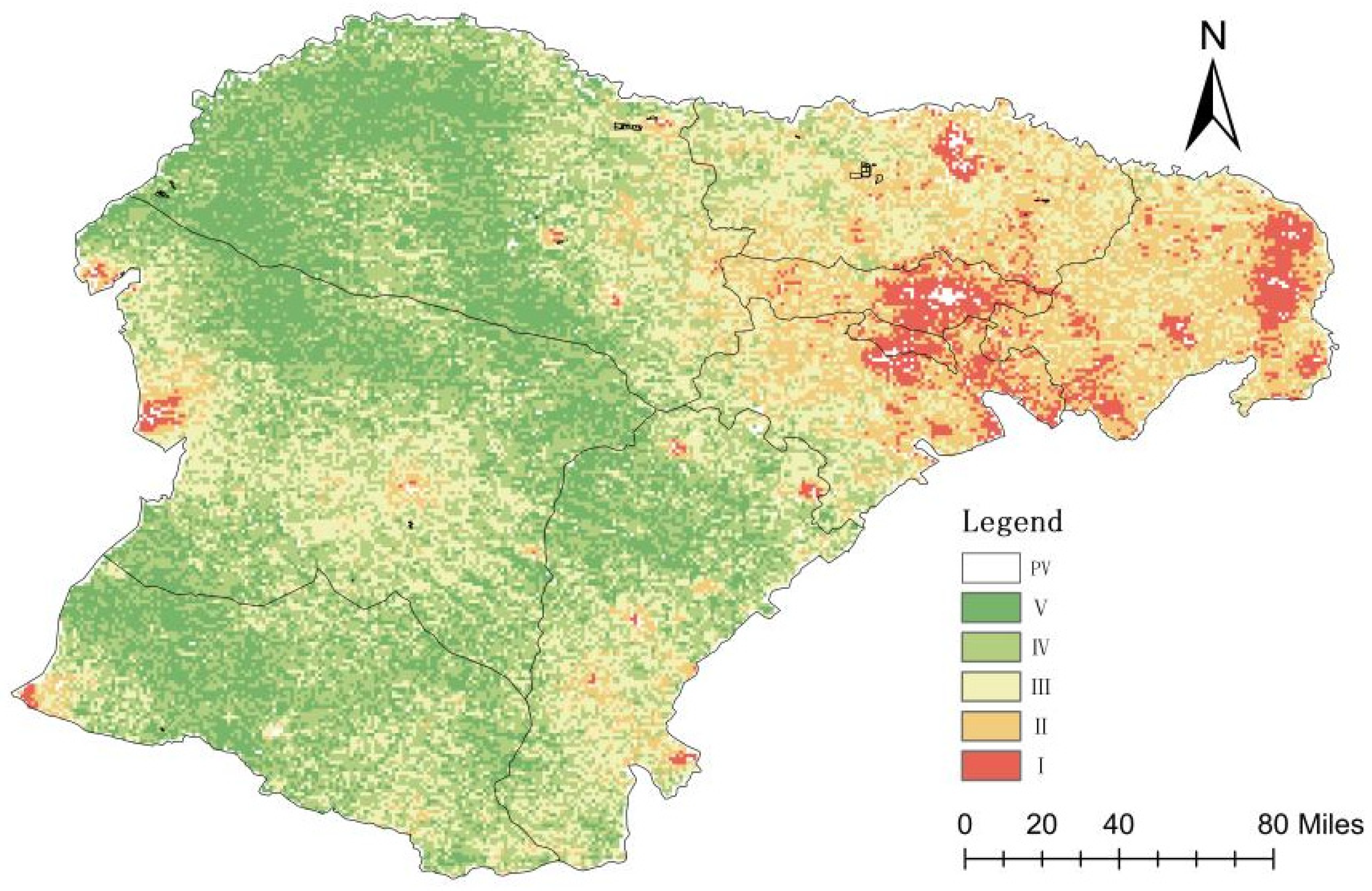
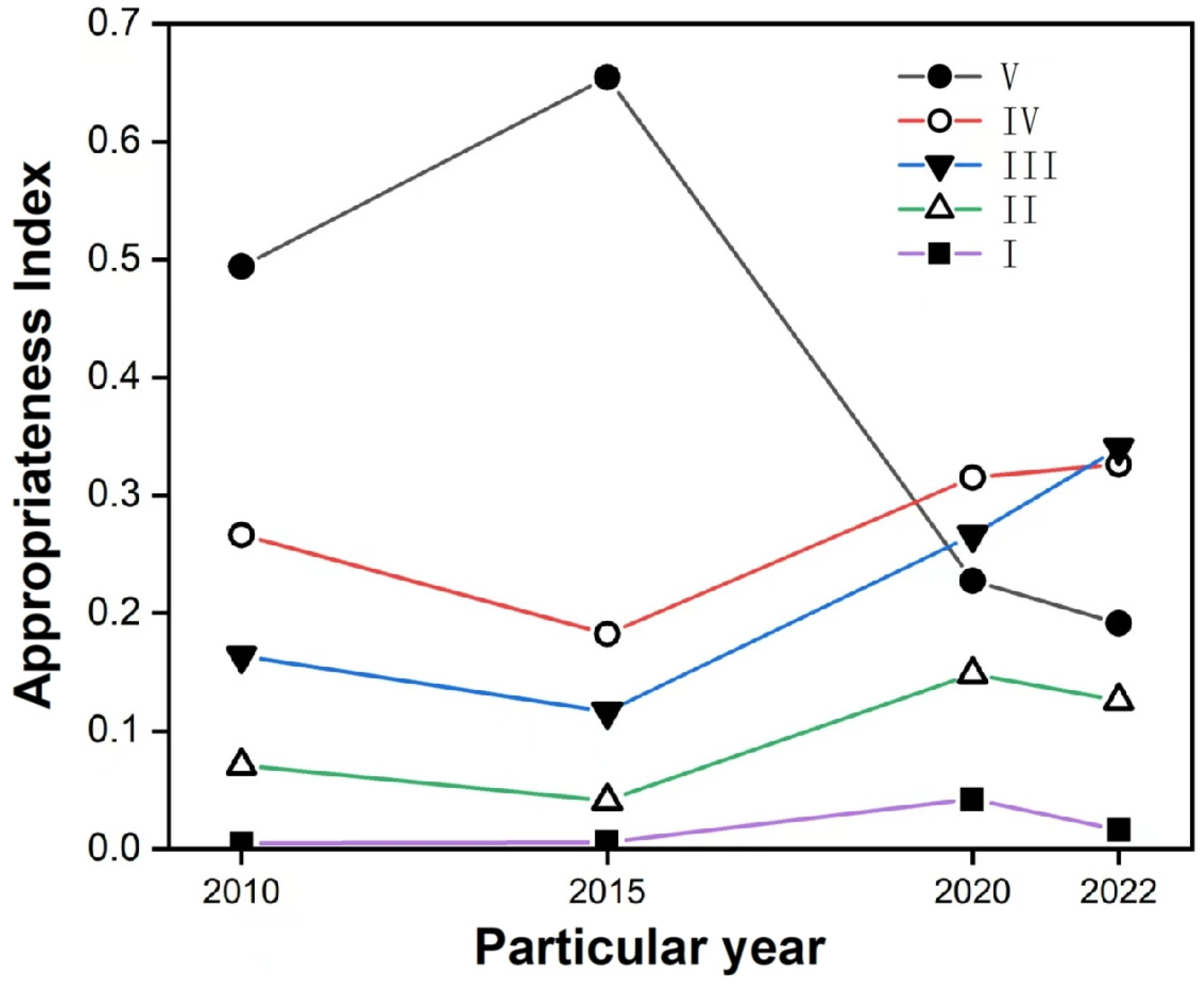
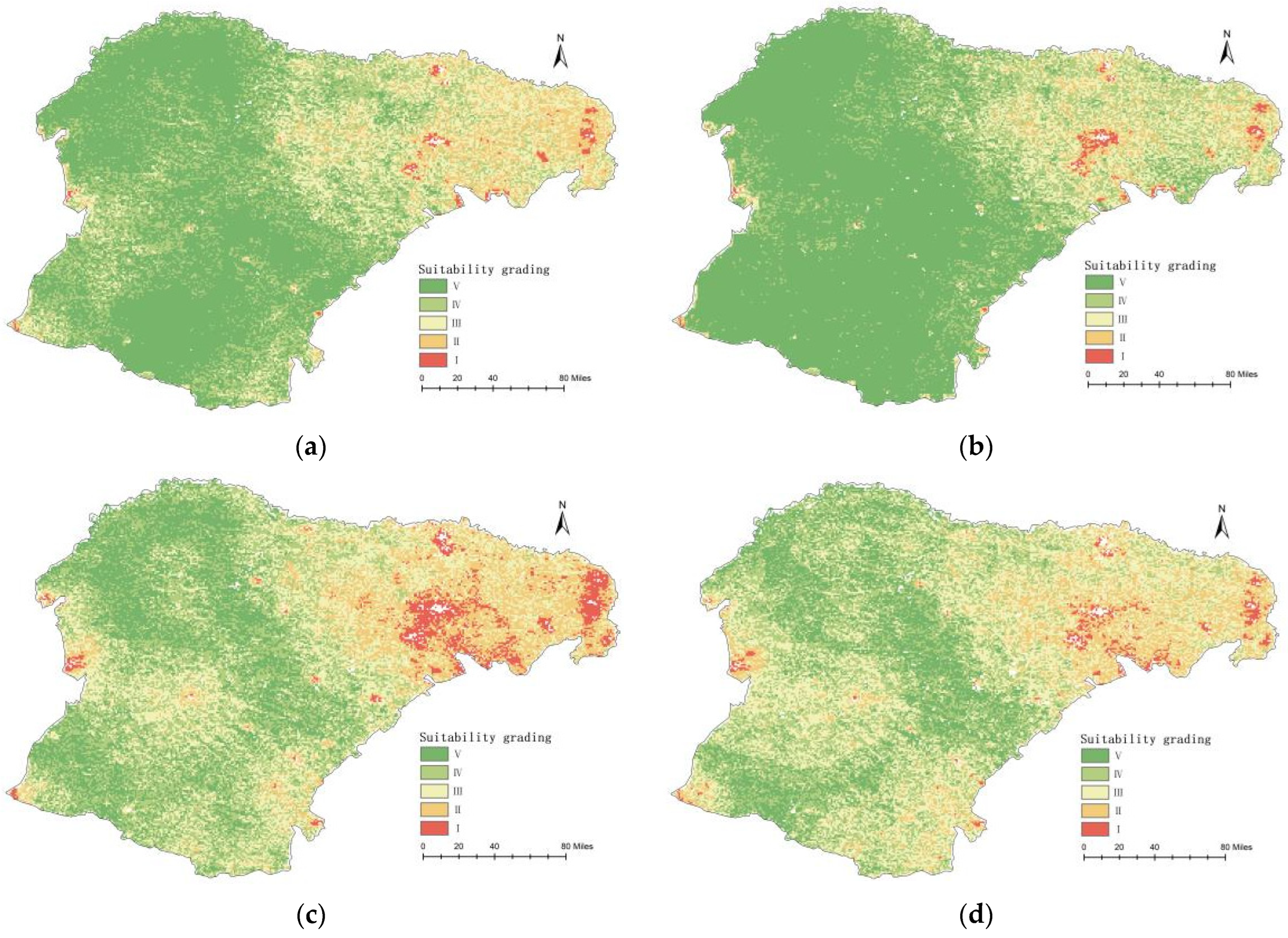
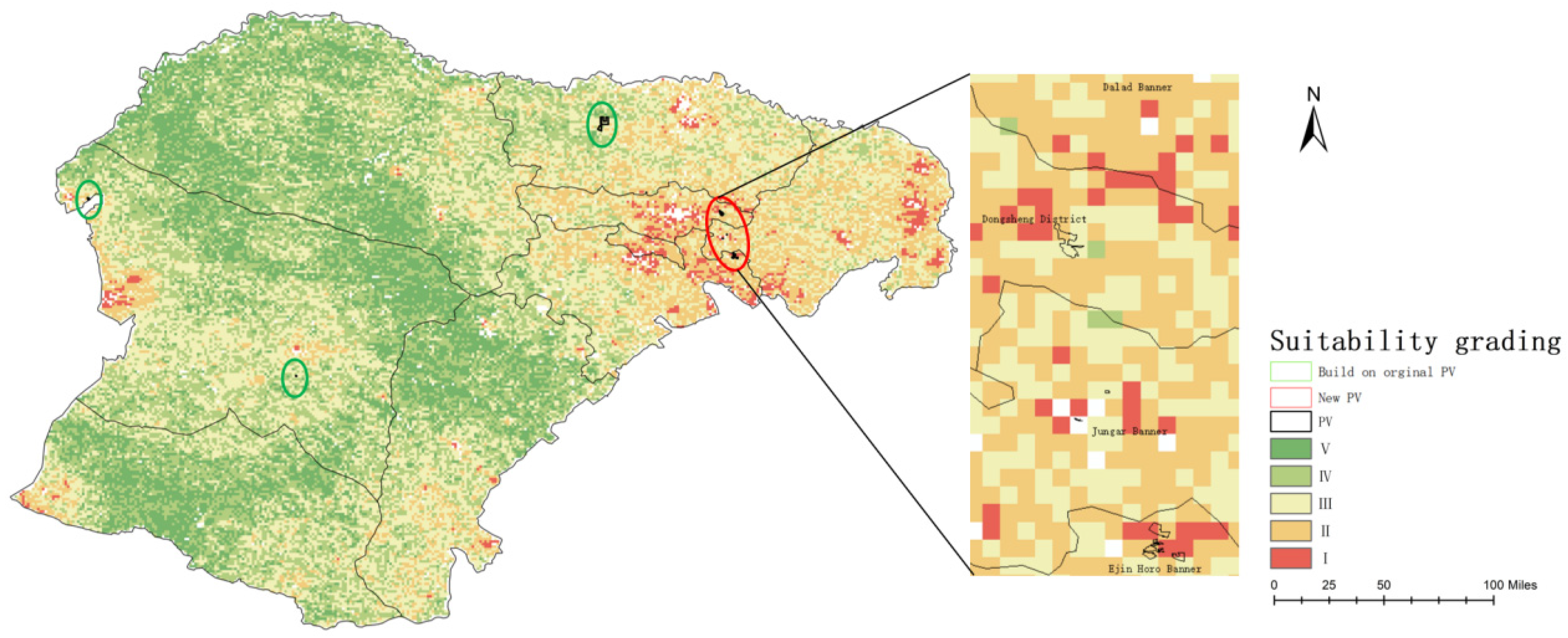

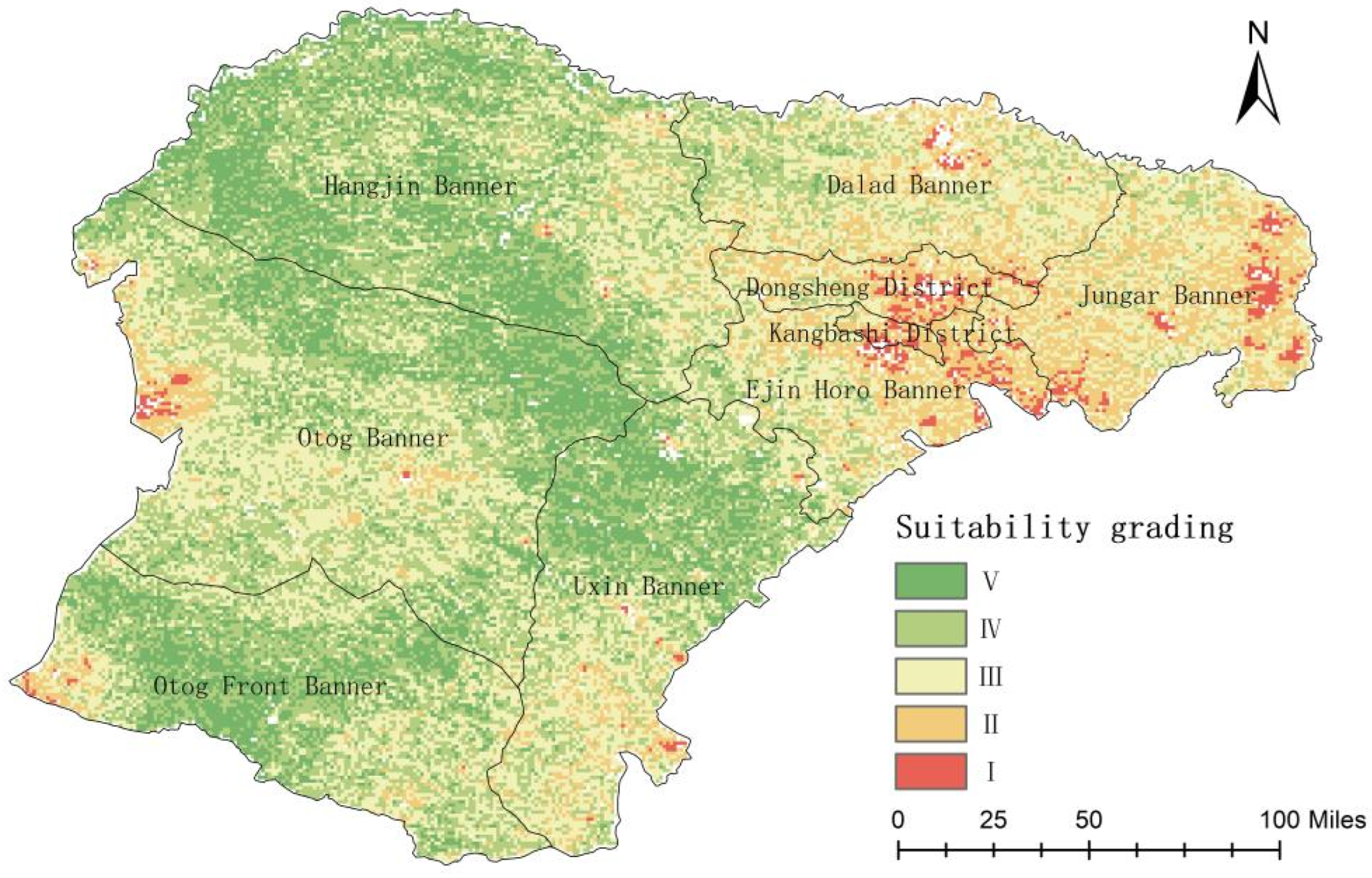
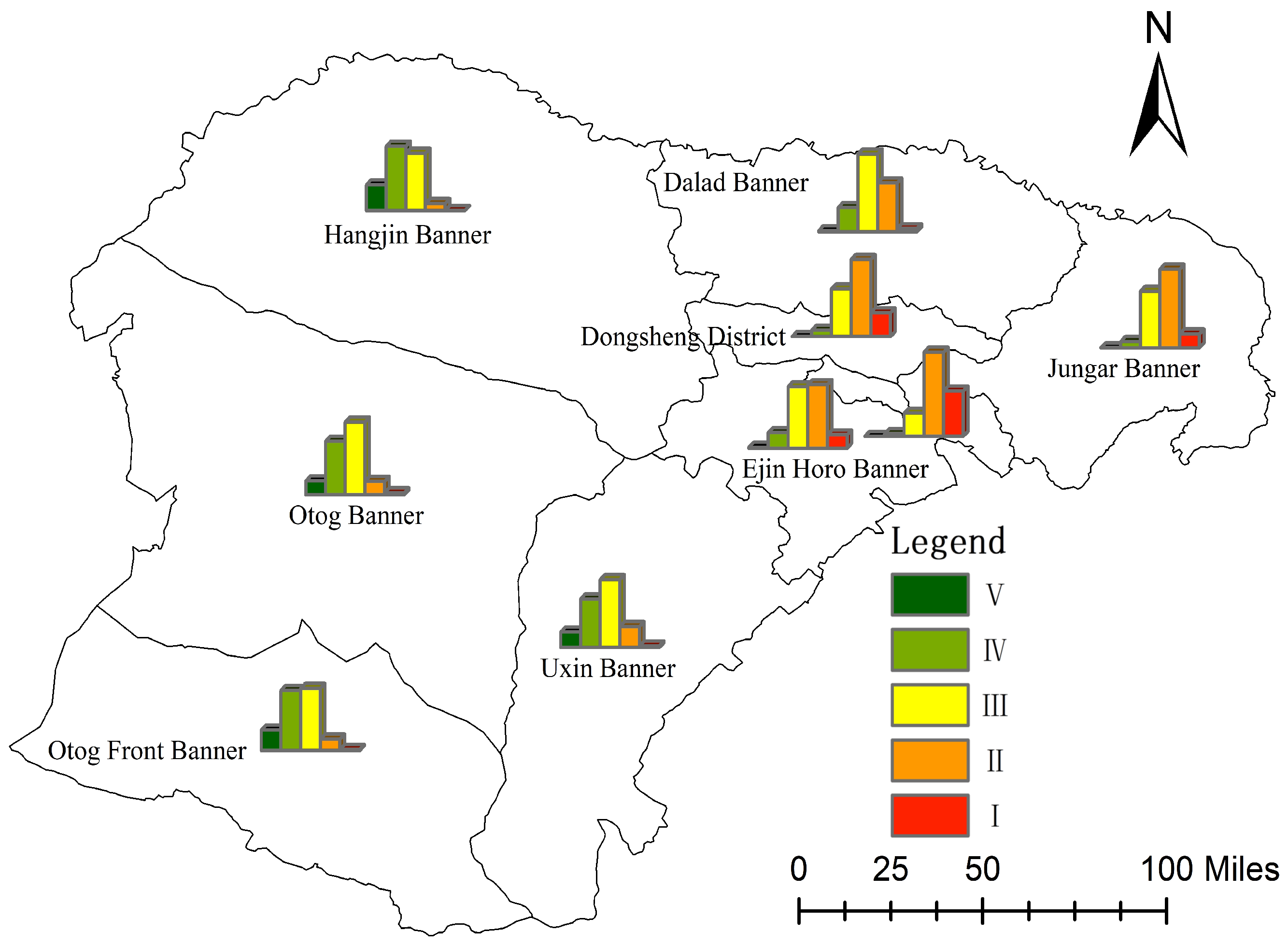
| Data Name | Processing Method | Resolution | Data Source |
|---|---|---|---|
| Slope, Aspect | Generated from DEM | 90 M | Geospatial Data Cloud |
| GHI | Masked and resampled to raster data | 250 M | World Bank Group |
| Land Cover Type | Masked and extracted from raster data | 30 M | Institute of Remote Sensing and Digital Earth, Chinese Academy of Sciences [12] |
| PM2.5, NO2 | Masked and resampled to raster data | 1000 M | National Tibetan Plateau Data Center |
| Distance to Roads, Rivers, Residential Areas | Euclidean distance analysis using OSM data | 250 M | Open Street Map Database |
| Precipitation, Wind Speed, Temperature | Kriging interpolation using ArcGIS | 500 M | National Centers for Environmental Information |
| Nighttime Light | Masked and resampled to raster data | 1000 M | Harvard Dataverse |
| NDVI | Calculated using LANDSAT5, 8 | 30 M | Google Earth Engine |
| Data Name | Weights (Pre-Improvement/Post-Improvement) | Data Name | Weights (Pre-Improvement/Post-Improvement) |
|---|---|---|---|
| Aspect | 0.09/0.08 | Distance to Roads | 0.02/0.04 |
| Slope | 0.04/0.05 | PM2.5 | 0.07/0.07 |
| Temperature | 0.08/0.08 | NO2 | 0.11/0.09 |
| GHI | 0.07/0.08 | Distance to Residential Areas | 0.03/0.05 |
| Precipitation, | 0.07/0.07 | Land Cover Type | 0.04/0.05 |
| Wind speed | 0.06/0.07 | Nighttime Light | 0.24/0.14 |
| Distance to Rivers | 0.06/0.07 | NDVI | 0.04/0.05 |
Disclaimer/Publisher’s Note: The statements, opinions and data contained in all publications are solely those of the individual author(s) and contributor(s) and not of MDPI and/or the editor(s). MDPI and/or the editor(s) disclaim responsibility for any injury to people or property resulting from any ideas, methods, instructions or products referred to in the content. |
© 2025 by the authors. Licensee MDPI, Basel, Switzerland. This article is an open access article distributed under the terms and conditions of the Creative Commons Attribution (CC BY) license (https://creativecommons.org/licenses/by/4.0/).
Share and Cite
Guo, Y.; Zhu, L.; Dou, L.; He, Y.; Wu, M. Spatiotemporal Analysis of Photovoltaic Potential in Ordos City Based on an Improved CRITIC Method. Land 2025, 14, 742. https://doi.org/10.3390/land14040742
Guo Y, Zhu L, Dou L, He Y, Wu M. Spatiotemporal Analysis of Photovoltaic Potential in Ordos City Based on an Improved CRITIC Method. Land. 2025; 14(4):742. https://doi.org/10.3390/land14040742
Chicago/Turabian StyleGuo, Yifei, Lanwei Zhu, Liduo Dou, Yuxin He, and Meiqing Wu. 2025. "Spatiotemporal Analysis of Photovoltaic Potential in Ordos City Based on an Improved CRITIC Method" Land 14, no. 4: 742. https://doi.org/10.3390/land14040742
APA StyleGuo, Y., Zhu, L., Dou, L., He, Y., & Wu, M. (2025). Spatiotemporal Analysis of Photovoltaic Potential in Ordos City Based on an Improved CRITIC Method. Land, 14(4), 742. https://doi.org/10.3390/land14040742







